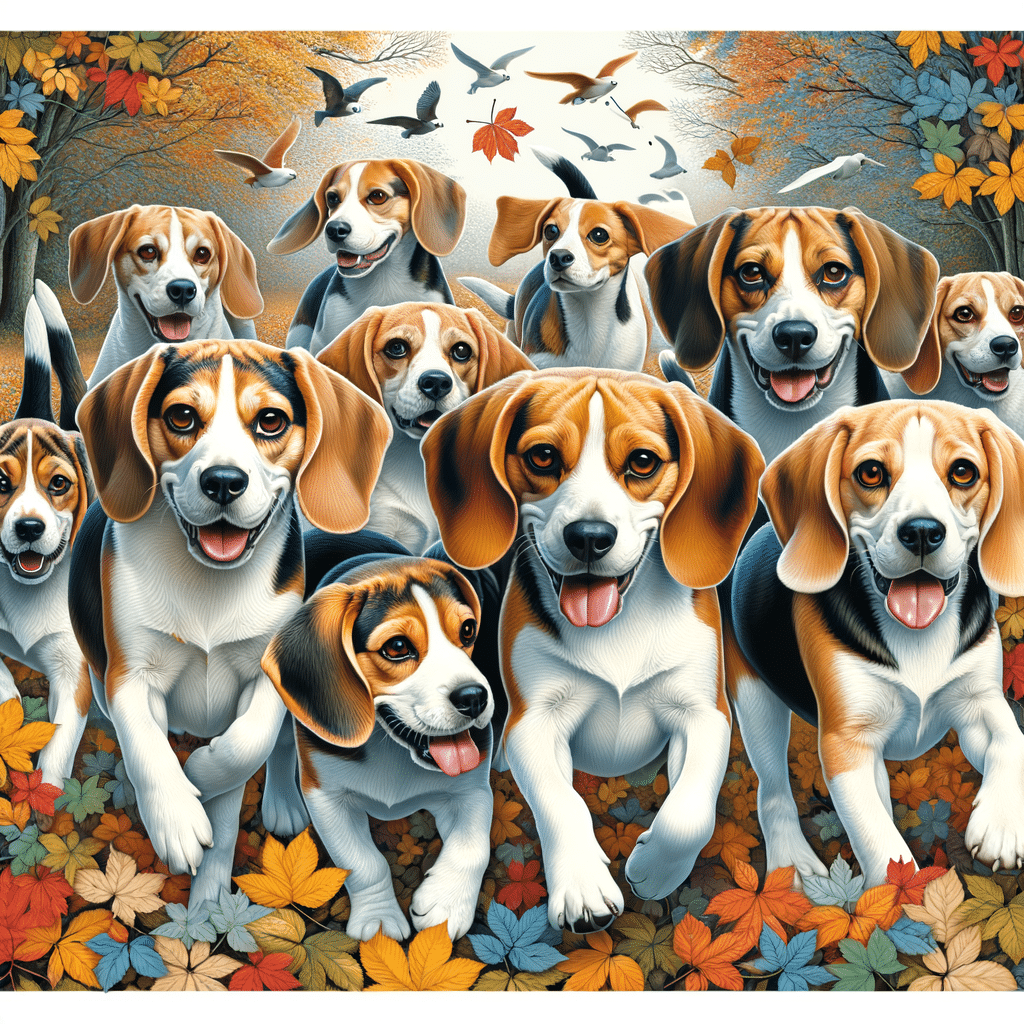When considering a new canine companion, potential dog owners often compare different breeds to find a match that suits their lifestyle and preferences. When considering the beagle vs. Doberman, contrasting the two breeds at the same time you compare them is a good idea.
In This Article
These are two popular breeds that, despite their differences, are both cherished by dog lovers worldwide. Originating from distinct backgrounds and bred for different purposes, each breed presents unique characteristics that may appeal to different households.
The beagle is known for its friendly demeanor and compact size, making it an excellent pet for families and those with limited living space. On the other hand, the Doberman pinscher, with its larger stature and protective instincts, is a loyal and active guardian.
Despite their differing appearances and temperaments, both breeds are intelligent and capable of forming strong bonds with their owners. This highlights the importance of understanding each breed’s specific care and activity requirements to ensure a happy, healthy pet.
Highlights
- Beagles and Doberman pinschers offer distinct advantages for different types of households.
- To compare dog breeds like these, understanding a breed’s personality, exercise needs, breed standard, and health considerations is crucial for any dog lover.
- Both beagles and Dobermans require a committed dog owner ready to meet their physical and emotional needs.
Breed Origins and History
Exploring the roots of the beagle and the Doberman pinscher reveals a rich tapestry of breed development, reflecting their origins in England and Germany, respectively, as well as their purposes in hunting and working roles throughout history.
Beagle Background
England is recognized as the birthplace of the beagle, a breed steeped in hunting heritage. Their history can be traced back to Roman times, but the modern breed was developed in the 1830s. Primarily used for hunting small game, the beagle’s keen sense of smell and tracking ability made them indispensable to hunters.
Doberman Pinscher Heritage
Originating from Germany in the late 19th century, the Doberman pinscher’s heritage is relatively young compared to other breeds. Created by Karl Friedrich Louis Dobermann, this breed was designed to be a robust working dog with a protective instinct, making them an excellent guard dog. Their history intertwines with Dobermann’s profession as a tax collector, where a reliable defender was necessary.
Physical Characteristics
In comparing the beagle and the Doberman pinscher, one can observe distinct differences in these popular dog breeds, including their physical makeup and grooming needs from a dog groomer.
Size Comparison
Beagle
- Weight: 20-30 pounds
- Height: 13-15 inches at the shoulder for males and females alike
Doberman Pinscher
- Weight: 70-100 pounds for males, 60-90 pounds for females
- Height: 24-28 inches for males, 24-26 inches for females
The stark contrast in size between the two breeds is apparent, with Dobermans being significantly taller and heavier than beagles.
Appearance and Grooming
Beagle Appearance
- Coat color options include a variety of hound colors, commonly tri-color or bi-color patterns consisting of white, tan, and black.
- Their short, dense coat is easy to maintain.
Doberman Pinscher Appearance
- They sport a sleek and smooth coat, and their coloring is typically black, red, blue, or fawn with rust markings.
- Their coat also requires minimal grooming.
- Beagles tend to shed moderately throughout the year.
- Due to a thicker undercoat, Doberman pinschers shed less frequently but may require more attention during seasonal changes.
Both breeds benefit from regular brushing to remove loose fur, but neither requires extensive grooming procedures, making their coats relatively easy to maintain.
Personality and Behavior
When comparing beagles to Doberman pinschers, prospective pet owners should consider the significant differences between the breeds regarding temperament and behavior. Each breed has distinct personality traits, levels of playfulness, dog health, and intelligence, which are important considerations for their compatibility with different lifestyles.
Temperament
Beagles are known for their happy and friendly disposition. They are often described as joyful and adventurous, displaying a loving and affectionate nature that makes them excellent family pets. Their curiosity drives them to want to constantly explore and play.
In contrast, Doberman pinschers are recognized for their alert and loyal personality. They can be fearless and are often regarded as one of the most intelligent dog breeds. While loving their families, they tend to have a more protective instinct than beagles and are superb watchdogs. They may have some independence but are also known for their obedience when adequately trained.
Activity and Exercise Needs
Beagles possess a high energy level but don’t require as much intense exercise as Dobermans. A beagle thrives on daily walks and playtime but can adapt to less active periods.
Doberman pinschers have very high energy levels and require vigorous exercise to maintain their physical and mental well-being. They are best suited to active owners who can provide ample play, exercise, and mental stimulation.
Training and Intelligence
Doberman pinschers excel in trainability and are often seen as more easily trainable due to their high intelligence and inclination toward obedience. They can perform various tasks with proper training and are frequently used in police and military roles. However, this intelligence requires consistent mental stimulation to prevent boredom.
Beagles, while also intelligent, can be more challenging to train. They are highly curious and easily distracted by scents, making training sessions requiring focus more difficult. However, they are trainable and capable of learning various commands and tricks with patience. Both breeds respond well to positive reinforcement techniques.
Health and Lifespan
When considering a beagle or Doberman pinscher, prospective owners should understand the common health issues that may affect each breed and their respective lifespans to ensure proper care and management of these beloved pets.
Common Health Issues
Beagles may experience the following health problems:
- Obesity: Prone to weight gain, which can lead to other health issues.
- Hip dysplasia: A genetic condition that can cause pain and mobility issues.
- Hypothyroidism: This can lead to changes in energy levels and weight.
Doberman pinschers are susceptible to:
- Hip dysplasia: Just like beagles, this is a concern for Dobermans.
- Von Willebrand’s Disease: A blood disorder that affects clotting.
- Obesity: Less common than in beagles, but still a concern for overall health.
Lifespan Considerations
- Beagles: They generally enjoy a long lifespan, 10-15 years, often reaching the higher end of their average if properly cared for.
- Dobermans: While they tend to have a slightly shorter average lifespan than beagles, 10 to 13 years, with attentive care, they can live to the older ages in their range.
Frequently Asked Questions
This section answers common inquiries regarding comparing beagles and Doberman pinschers, focusing on their differences in temperament, size, suitability for families, cohabitation, exercise needs, and health concerns.
What are the differences in temperament between beagles and Dobermans?
Beagles are known for their friendly and sociable nature, making them suitable for families and children. They are generally good-natured and eager to please. Conversely, Dobermans have high levels of loyalty and protective instincts, featuring a more alert and assertive character than beagles.
How do beagles and Dobermans compare in size?
A beagle is a small to medium-sized breed, often reaching up to 15 inches in height and weighing roughly 20 pounds. Contrastingly, a Doberman pinscher is a larger breed, standing significantly taller at around 26 inches at the shoulder and weighing up to 75 pounds.
What are the considerations when choosing between a beagle and a Doberman for family pets?
Families should consider the beagle’s high sociability and compatibility with children. Dobermans require firm training and socialization but can also be good family pets with the proper guidance. The size and energy level of the breed should match the family’s living situation and lifestyle.
Can beagles and Dobermans live together harmoniously?
Beagles and Dobermans can cohabit peacefully with proper introduction and socialization. Both breeds have a pack mentality, and if they are raised with clear boundaries and positive reinforcement, they can form a harmonious relationship.
What are the exercise requirements for beagles versus Dobermans?
Beagles possess a moderate energy level and require daily walks and playtime for mental stimulation. Dobermans have higher energy and stamina, necessitating regular, vigorous exercise to maintain their physical and mental health.
How do health issues compare between beagles and Dobermans?
Beagles are generally hardy but prone to obesity, ear infections, and certain genetic health issues. Dobermans may face more severe health concerns, like cardiomyopathy and hip dysplasia. They typically have a shorter lifespan compared to beagles. Potential owners should consider the breed group’s specific health risks and related care commitments.






